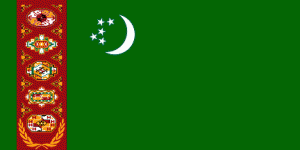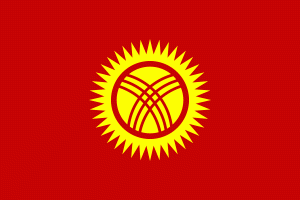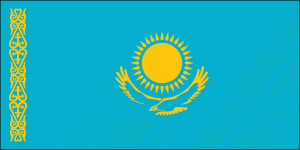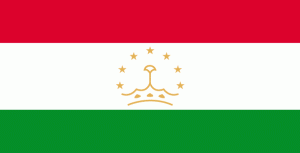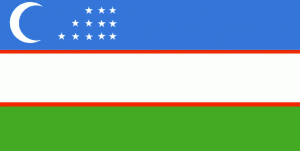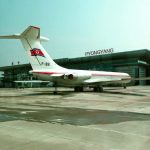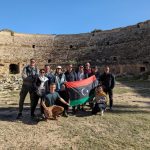Central Asia already has a lot going for it – dictators and post-soviet bureaucracy, coupled with mountains, deserts, yurts and the Silk Road. What’s often overlooked is how unique and interesting the Central Asian flags are!
 Turkmenistan Flag
Turkmenistan Flag
This is the only flag in the world with pictures of carpets on it. Carpets are a pretty big deal in Turkmenistan. They’re very proud of their prosperous carpet industry and pictures of carpets are found everywhere – posters, signposts, petrol stations, book covers, even vending machines. The carpet museum in Ashgabat is one of the most expensive attractions in the whole country and the government holds an annual festival that is devoted entirely to carpets.
The five carpets that run down the left-hand side of the flag represent the five tribes of Turkmenistan. This is a concept that was re-introduced by Turkmenbashy to give the Turkmen people back a sense of national identity after the fall of the Soviet Union. When the Soviet Union disintegrated, people all over were looking for a sense of identity, grasping at their roots and history to feel part of a tangible community. In returning to the people a feeling of being Turkmen, Turkmenbashy united them and solidified his position as their president. Although there are barely remnants of the religion now, since it was nicely beaten out of them by the Soviet Union, the crescent moon is to represent Turkmenistan’s Islamic heritage, with the five stars to once again point towards the five tribes. The crossed olive branches at the bottom of the carpet motif, similar to the one found on the UN flag, symbolises Turkmenistan’s “status of permanent neutrality”.
Click here for information on our tours to Turkmenistan.
 Kyrgyzstan Flag
Kyrgyzstan Flag
This is the only flag in the world that has a representation of a yurt on it. Yes, another flag with the only something in the world. The yellow circle with a cross in the centre of the flag is in fact the shape that is found at the top of every yurt. Yurts are somewhere between permanent tents and temporary houses, and are the homes that nomadic people, of which there are still many in Kyrgyzstan, live. They are made by draping layers and layers of hand-made felt over a wooden frame, forming a sort of tee-pee shape. They’re really easy to assemble and disassemble (within the context of them being houses) and are literally picked up and moved when need be.
Want to visit?
 Kazakhstan Flag
Kazakhstan Flag
A very distinctive flag with its yellow design on a sky blue background, this visually is one of my favourite flags. The ornamental pattern down the left-hand side of the flag is called “koshkar muiz” which means “the horns of the ram”, and represents the art and cultural traditions of the Kazakh people. The steppe eagle which makes up part of the central design is a symbol that has appeared on tribal flags for centuries and represents freedom and power. The sun which rests atop the eagle has rays that are in the shape of grains of wheat, which ironically (given the huge expanse of Kazakhstan that is the completely barren desert) is supposed to represent the prosperity of the land.
More information on tours here.
 Tajikistan Flag
Tajikistan Flag
The Tajik SSR flag was the only SSR flag to display the pan-Iranian colours of red, white and green, an uncharacteristically sensitive acknowledgement by the USSR to Tajikistan’s Persian culture and heritage. At the time of Independence, Tajikistan decided to keep the colours, forming a tri-colour flag. They introduced a gold crown and seven stars to the centre of the flag, the crown representing the new-found independence of the nation, and the number seven being a lucky number to Tajiks. Because of the tri-colour and the gold symbol in the centre, the flag has ended up looking very similar to that of Iran. Possibly more interesting than the flag itself though, Dushanbe’s flagpole has caught our interest. Until May 2011, Azerbaijan had the title of having the world’s tallest flagpole, but after two years of design and construction, Tajikistan took the title. Costing $3.5 million, the pole itself is 165 m tall, and flies a flag that weighs 700 kg! Sadly in 2014, Saudi Arabia nabbed the title by building a 175 m tall flagpole in Jeddah, so now we have to settle for having the world’s second tallest flagpole. Incidentally, at 133 m, Ashgabat still comes in with number five, behind North Korea in fourth place.
Want to visit Tajikistan?
 Uzbekistan Flag
Uzbekistan Flag
Uzbekistan was the first of the Central Asian republics to choose a new flag after becoming independent from the USSR. They chose a tri-colour with thin red bands between each block, to symbolise peace and purity, water and sky, nature and fertility, and the “life-force” within the Uzbek people. In the top left-hand corner is a crescent moon for the Islamic history of Uzbekistan, and twelve stars which represent the months of the Islamic calendar and the signs of the Zodiac. Although this is possibly the least unique flag of Central Asia (well it certainly isn’t the most unique!), they are very very proud of this flag, and it is plastered all over the place. The tri-colour appears on lamp posts, posters, murals, flags, advertising, and much more. At any one point whilst in Uzbekistan, you can probably see the flag, or some part of it. In 2010 though, President Islam Karimov, decided that he was sick of everyone using his flag, so he banned anyone that isn’t working directly with the Uzbek government from using the flag, or any part of it, in any sort of production.
Is there a Central Asia flag?
Visit Uzbekistan with YPT this year!


